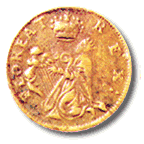
Plinky's Coin of the Month
March 2000
In the 1680s, people in West New Jersey used this copper farthing instead of wampum. Although the coin is English, an Irish saint appears on the reverse. Can you name him?
Hint: Legend has it that this saint drove all the snakes out of Ireland.
If you knew the answer was St. Patrick, count it as a shamrock in your cap! The coin shown here is the St. Patrick Copper Farthing. There's also a St. Patrick Copper Halfpenny. Mark Newby, an English merchant, brought a large supply of both when he came to the colonies from Dublin, Ireland. For this reason, the coins are also called "Mark Newby Coppers."
In May 1682, the General Free Assembly of West New Jersey declared Newby's coins legal tender, saying the coppers could circulate at the rate of a halfpenny and replace wampum. It didn't say if it meant the farthings or halfpennies, though. Some people believe the assembly meant the farthing, which were worth one-quarter of a cent. Why? Because English coins often were worth double their face value in the colonies.
The obverse of both the farthing and the halfpenny show a king kneeling and playing a harp. There's also a crown separating the legend at the top of the coins. Brass inserts were placed over the crown for two reasons—to make the coins harder to counterfeit and to give the royal English crown a golden appearance. On some coins this brass decoration no longer shows.


